Related Research Articles

John Maitland, 1st Duke of Lauderdale, KG, PC was a Scottish statesman and peer.

Charles Maitland, 3rd Earl of Lauderdale, was the second son of John Maitland, 1st Earl of Lauderdale and his wife Isabel Seton.

The former Royal Burgh of Lauder is a town in the Scottish Borders in the historic county of Berwickshire. On the Southern Upland Way, the burgh lies 27 miles (43 km) southeast of Edinburgh, on the western edge of the Lammermuir Hills.
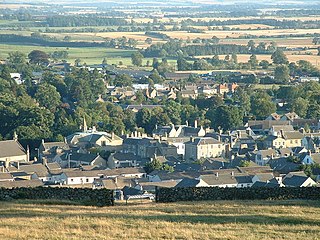
Duns is a town in the Scottish Borders, Scotland. It was the county town of the historic county of Berwickshire.

The Agricultural Revolution in Scotland was a series of changes in agricultural practice that began in the 17th century and continued in the 19th century. They began with the improvement of Scottish Lowlands farmland and the beginning of a transformation of Scottish agriculture from one of the least modernised systems to what was to become the most modern and productive system in Europe. The traditional system of agriculture in Scotland generally used the runrig system of management, which had possibly originated in the Late Middle Ages. The basic pre-improvement farming unit was the baile and the fermetoun. In each, a small number of families worked open-field arable and shared grazing. Whilst run rig varied in its detail from place to place, the common defining detail was the sharing out by lot on a regular basis of individual parts ("rigs") of the arable land so that families had intermixed plots in different parts of the field.
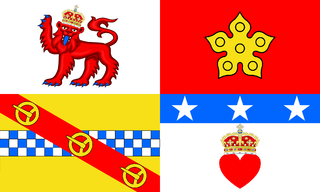
The Mormaer or Earl of Angus was the ruler of the medieval Scottish province of Angus. The title, in the Peerage of Scotland, is held by the Duke of Hamilton, and is used as a courtesy title for the eldest son of the Duke's eldest son.

Alexander Seton, 1st Earl of Dunfermline was a Scottish lawyer, judge and politician. He served as Lord President of the Court of Session from 1598 to 1604, Lord Chancellor of Scotland from 1604 to 1622 and as a Lord High Commissioner to the Parliament of Scotland.
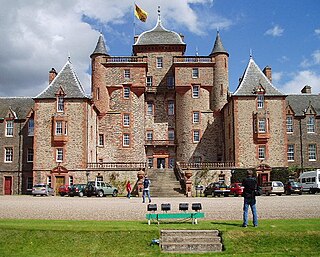
Thirlestane Castle is a castle set in extensive parklands near Lauder in the Borders of Scotland. The site is aptly named Castle Hill, as it stands upon raised ground. However, the raised land is within Lauderdale, the valley of the Leader Water. The land has been in the ownership of the Maitland family since 1587, and Thirlestane served as the seat of the Earls of Lauderdale. The castle was substantially extended in the 1670s by the first and only Duke of Lauderdale. Further additions were made in the 19th century. The castle is now cared for by a charitable trust, and is open to the public.

Sir Andrew Ramsay, Lord Abbotshall, Privy Counsellor, was the first Lord Provost of Edinburgh and a judge of the Court of Session.
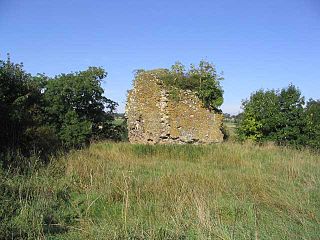
Whitslaid Tower was an ancient Berwickshire seat of the Lauder family for over 300 years. It is today a ruin high above the eastern bank of the Leader Water, 2 miles (3.2 km) south of the burgh of Lauder, in the Scottish Borders. In feudal times it fell within a detached segment of the King's personal Barony of Renfrew.

Bonkyll Castle was a medieval fortress situated in the historic Scottish county of Berwickshire, from 1973 the Scottish Borders. It is situated 4 miles north of Duns and 4 miles south of Grantshouse. Few traces survive and the site is protected as a scheduled monument. It was the seat of a junior branch of the Stewart family, known as "Stewart of Bonkyl", from which was descended in another junior branch "Stewart of Darnley", the paternal family of King James VI & I of Scotland and England.
John Swinton (1621?–1679) was a Scottish politician active during the Wars of the Three Kingdoms and during the Interregnum. At the Restoration he was found guilty of treason and was imprisoned for some years before being released. In later life he became a Quaker.

Margaret Keswick Jencks was a Scottish writer, artist and garden designer who co-founded Maggie's Centres with her husband Charles Jencks.
James Hardy LL.D. was a Scottish naturalist and antiquarian. He was secretary of the Berwickshire Naturalists' Club from 1871 until at least 1896. At least two species have been named in his honour.
Mary (Dudley) Sutton, Countess of Home (1586–1644), was a landowner, living in England and Scotland.
Mary Campbell, Countess of Argyll, formerly Lady Mary Stuart, was the wife of Archibald Campbell, 9th Earl of Argyll.
John Murray, 1st Earl of Annandale was a Scottish courtier and Member of Parliament.
Margaret Lyon was a Scottish aristocrat and landowner.
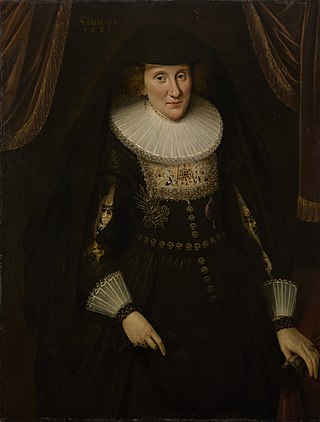
Anna Hay, Countess of Winton (1592-1628) was a Scottish courtier.

David Jonkin or Jenkin was a Scottish merchant and shipowner. He imported sugar, French wine, Swedish timber, linen from Haarlem, and lint from Poland.
References
- 1 2 3 4 5 6 7 8 9 10 11 12 Ewan, Elizabeth, ed. (2018). The new biographical dictionary of Scottish women. Edinburgh: Edinburgh University Press. pp. 189–190. ISBN 978-1-4744-3629-8. OCLC 1057237368.
- 1 2 3 4 5 6 7 8 Kirsten (2021-05-03). "Midside Maggie – a Traditional Borders Tale". Scot Stories. Retrieved 2023-03-09.
- ↑ "National Museums of Scotland - Girdle, known as Midside Maggies Girdle". nms.scran.ac.uk. Retrieved 2023-03-09.